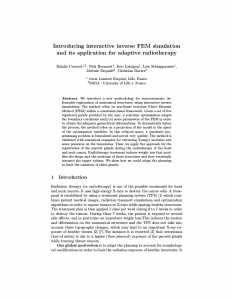Introducing interactive inverse FEM simulation and its application for adaptive radiotherapy
E. Coevoet, N. Reynaert, E. Lartigau, L. Schiappacasse, J. Dequidt and C. Duriez
Abstract
We introduce a new methodology for semi-automatic deformable registration of anatomical structures, using interactive inverse simulations. The method relies on non-linear real-time Finite Element Method (FEM) within a constraint-based framework. Given a set of few registered points provided by the user, a real-time optimization adapts the boundary conditions and(/or) some parameters of the FEM in order to obtain the adequate geometrical deformations. To dramatically fasten the process, the method relies on a projection of the model in the space of the optimization variables. In this reduced space, a quadratic programming problem is formulated and solved very quickly. The method is validated with numerical examples for retrieving Young’s modulus and some pressures on the boundaries. Then, we apply the approach for the registration of the parotid glands during the radiotherapy of the head and neck cancer. Radiotherapy treatment induces weight loss that modifies the shape and the positions of these structures and they eventually intersect the target volume. We show how we could adapt the planning to limit the radiation of these glands.
 17th International Conference on Medical Image Computing and Medical Asserted Intervention (MICCAI), 2014
17th International Conference on Medical Image Computing and Medical Asserted Intervention (MICCAI), 2014
Paper
@article{coevoet2014,
title = {{Introducing interactive inverse FEM simulation and its application for adaptive radiotherapy}},
author = {Coevoet, Eulalie and Reynaert, Nick and Lartigau, Eric and Schiappacasse, Luis and Dequidt, J{\’e}r{\’e}mie and Duriez, Christian},
booktitle = {{MICCAI}},
year = {2014}}
Video



